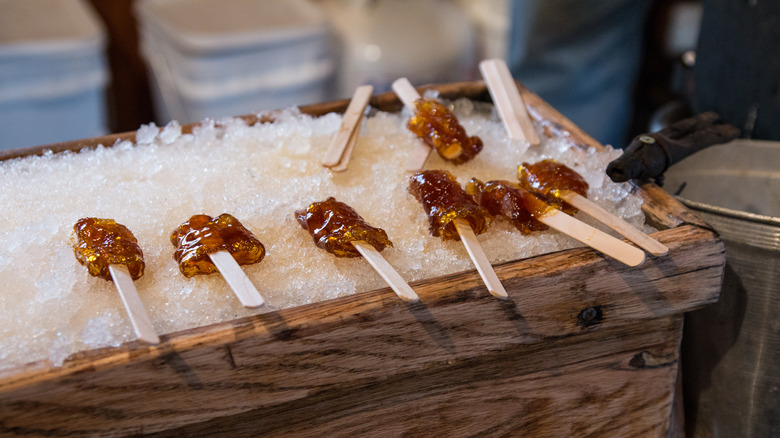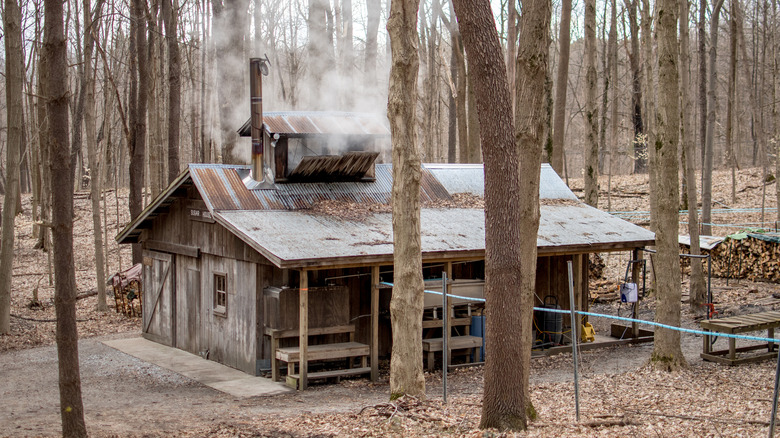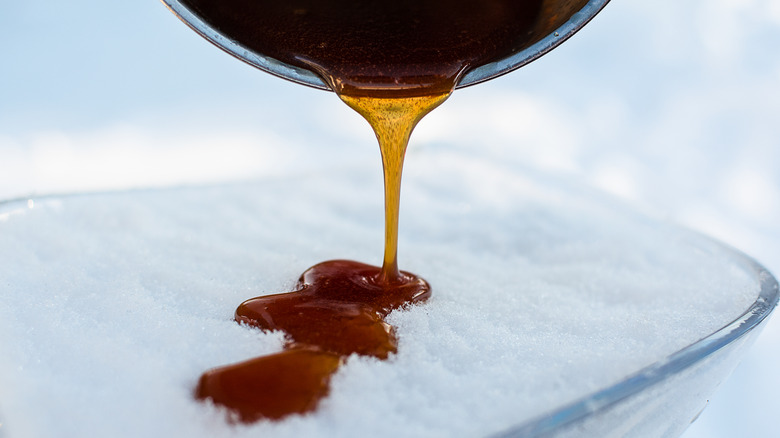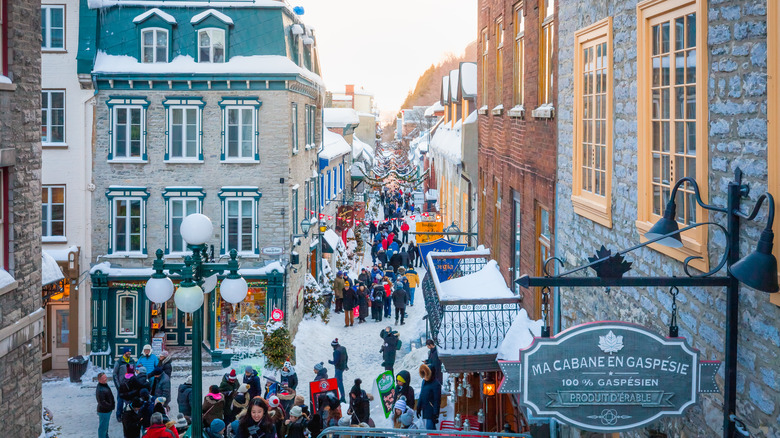Quebec's Tire D'érable Is A Must-Try Winter Treat
We hate to break it to you, but your favorite go-to syrup for your pancakes is most likely not real maple syrup. The easiest way to tell if you're buying real or fake maple syrup is to read the ingredient list. Anything filled with corn syrup or other additives is not the pure caramel-y stuff straight from a tree. But, if you find yourself driving through the Northeastern U.S. or Eastern Canada, you're likely to find a local brand of pure maple syrup in no time.
Many people know that most of the world's maple syrup comes from Canada, but did you know the province of Québec creates the most in the nation? It's an iconic symbol of the province, alongside the fleur-de-lis and classic poutine. With so much maple syrup flowing through the province in the winter months, maple candies and desserts are commonly enjoyed during this time. But, the most traditional, and possibly most delicious, way to enjoy maple syrup may be tire d'érable.
Tire d'érable, directly translating to "drawn maple," refers to the process in which it's made. It's also called tire sur la neige throughout French Canada and maple taffy in English. It's a truly unique winter treat that has a one-of-a-kind texture. This dessert can be traced back to the indigenous peoples that occupied Canada long before the French and English colonizers. So, if you want a true French Canadian winter experience, it's worth learning about the classic tire d'érable.
History of tire d'érable
According to the Modern Farmer, tire d'érable has been around for centuries, and it can be traced back to indigenous tradition. According to American Express Essentials, while the first discovery of maple syrup is unknown, there is lore around its origin. Legend says that maple water, the substance that comes from maple trees and is later boiled into syrup, was first discovered by the Indigenous people of Canada after they saw a squirrel licking it off a maple tree. Soon, indigenous communities began to tap into this resource. They used it to cure meats, which proved to be an essential preservation tactic during harsh winters.
Later, when the French colonizers arrived, it was also a heavily utilized resource, as per the site. It is not a surprise that this was commonly enjoyed since this area of the continent is home to vast acres of maple trees, according to Modern Farmer.
Maple From Canada adds that many Québec children have enjoyed eating tire d'érable through the centuries, and the practice is passed down through generations. As many Québécois know, eating this treat is also a sign that winter will soon be coming to an end.
How tire d'érable is made
The process of making tire d'érable starts with — of course — making maple syrup. According to CT Maple, the process of making maple syrup is centuries old, but time has brought along new technologies to help aid the modern process. The site outlines the five steps it takes to bring fresh and pure maple syrup to tables around North America: preparation, tapping, identifying trees, collecting sap, and filtering and packing the syrup.
The season typically runs from early February to late March, as this time of year's cold nights and warmer days help the sap easily flow from the trees. Certain sugar maple trees are chosen and tapped, and the collection process can begin, as per CT Maple. According to the outlet, sap is either collected by a bucket and spout method or a "pipeline tubing" method.
Once the sap is collected, it has to be boiled down into syrup, as per Heifer. The site notes that it is officially considered syrup when the sugar content reaches 66% or a certain high temperature. The syrup is then strained and packaged into bottles while it's still hot, as the outlet notes.
This summary is brief, however, and the actual process is much more complicated and often done by expert sugarmakers.
When it finally comes to making tire d'érable, the maple syrup is boiled and poured onto soft, clean slow to become the beloved winter treat, according to First We Feast.
How tire d'érable is eaten and where to find it
According to Maclean's, when you find a tire d'érable stand, the process is pretty simple if you want to try this dish out. First, you can buy a popsicle stick from the sales person at the stand. They usually run very cheap, likely just a few loonies or toonies. Then, you will go to the bed of snow where another person is waiting for you. They will ladle, in a line, the hot syrup onto the snow for you. You can then place the stick onto the syrup, wait a moment for the syrup to firm up, and then roll the popsicle stick down the line. Finally, it's ready to eat.
According to First We Feast, the texture is firm when you bite into it, but it melts quickly in your mouth. It also doesn't taste overly sweet as one would expect. The snow crystals that join the syrup also add to the overall texture and flavor as they too melt in your mouth.
Whether you're strolling through a Montréal Christmas market or you've traveled to Québec City for their famed annual Carnaval de Québec, you're more than likely to stumble upon a tire d'érable stand. Rural Québec sugar shacks also often offer this treat to passers-by, as per Modern Farmer. They're very popular throughout the winter and early spring seasons, so we recommend braving the cold to try this one-of-a-kind treat.



